Tag archives: space missions
The February 2018 issue of Physics World magazine is now out
 By Matin Durrani
By Matin Durrani
You’ll be delighted to know that the February 2018 issue of Physics World is now out in print and digital format.
In our cover feature this month, science writer Jennifer Ouellette discovers how tiny midges can shed light on collective behaviour in physics. You can also discover from Helen Gleeson how physicists are seeking to create liquid-crystal contact lenses – and learn from Stephen Ornes more about the technological challenges of going to Mars.
Don’t miss either our interview with the physicist who heads Japan’s leading funding agency and find out from astrophysicist Elizabeth Tasker about her experiences as an overseas scientist in the country.
And our veteran North America correspondent Peter Gwynne assesses the impact that Donald Trump has had on US science, one year into his presidency.
Remember that if you’re a member of the Institute of Physics, you can read the whole of Physics World magazine every month via our digital apps for iOS, Android and Web browsers.
Let us know what you think about the issue on Twitter, Facebook or by e-mailing us at pwld@iop.org
View all posts by this author | View this author's profile
Einstein, Hawking and Rees set to music, singing about virtual particles, tiny satellite will soon blast off
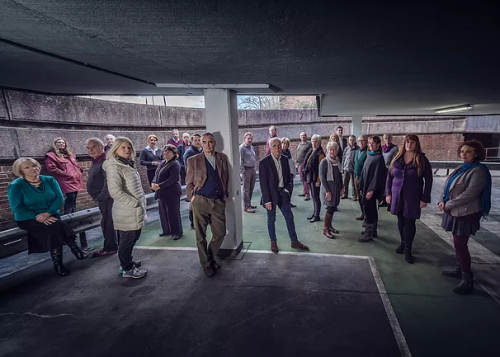
Singing multiverse: the Salisbury Chamber Chorus. (Courtesy: Salisbury Chamber Chorus)
By Hamish Johnston
“What I wanted to write was something about the universe and our place in it: from the Big Bang, through our insignificance in the vastness of it all, our need for exploration and where space travel will take us, to the nature of light or the make-up of electrons, and finally ideas about multiverses and infinity.”
That is the motivation behind the “secular oratorio” Space Time Matter Energy by Simon McEnery, which premieres at St Mary le Strand Church in London on 10 June. The piece melds the words of famous physicists such as Stephen Hawking, Martin Rees and Albert Einstein with music and song from the Salisbury Chamber Chorus, the percussion ensemble Beaten Track and the pianist Peter Toye. If you can’t be in London on the 10th, there is also a performance in Salisbury on 17 June.
View all posts by this author | View this author's profile
Hidden Figures behind NASA’s success, LEGO’s famous five women of space, seismic goal in Barcelona
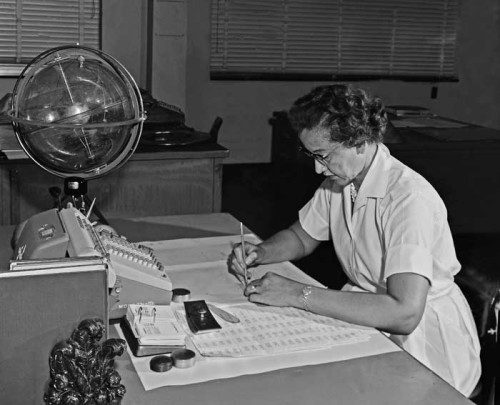
Flight planner: NASA’s Katherine Johnson now has a NASA computational facility named after her. (Courtesy: NASA)
By Hamish Johnston
International Women’s Day was this week and to celebrate, we have published K Renee Horton’s review of the film Hidden Figures and the book by Margot Lee Shetterly that the film is based on. The book and film tell the true stories of African-American female mathematicians who worked at NASA and played a crucial role in America’s race into space during the Cold War. Indeed, they calculated the flight paths that would send Neil Armstrong to the Moon.
View all posts by this author | View this author's profile
Music for aliens, Doctor Strange’s science adviser, the physics of Bob Dylan
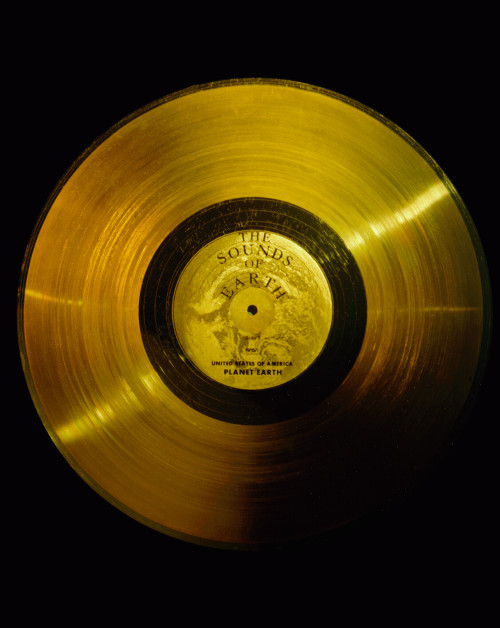
Sounds of Earth: An original golden record. (Courtesy: NASA)
By Hamish Johnston
An online initiative to reissue Carl Sagan’s golden record, which was attached to NASA’s Voyager 1 and 2 craft, has so far raised a whopping $1.1m, smashing its $198,000 goal. The campaign was created in September by David Pescovitz, editor and managing partner at the technology news site Boing Boing, after teaming up with Timothy Daly from Amoeba Music in the US, who was the original producer of the record, as well as US graphic designer Lawrence Azerrad. The original LP, which was created in 1977, contains sounds of the Earth along with recorded greetings and a mix of music, and has been unobtainable for decades, having been available only on CD-ROM in the early 1990s. Now that the cash has been raised, the golden record will be released next year as an LP to mark the 40th anniversary of the Voyager launches. So how much will it set you back? It’s yours for only $98, what a bargain.
View all posts by this author | View this author's profile
Mercury now orbits between Mars and Jupiter, fun with liquid nitrogen, 3D printing an asteroid
By Hamish Johnston
He may have taken the name of a planet, but the late rock star Freddie Mercury now has an asteroid named after him. 17473 Freddiemercury, is about 3.4 km in diameter and resides in the main asteroid belt between Mars and Jupiter. The designation was made by the Minor Planet Center of the International Astronomical Union and announced on Sunday by Mercury’s former Queen band mate and astrophysicist Brian May. In the above video, May gives some background to the naming, which was done to celebrate the 70th anniversary of Mercury’s birth. And if you watch to the end, you will see a clip of 17473 Freddiemercury streaking across the sky with Queen rocking in the background.
View all posts by this author | View this author's profile
Primal colours across the spectrum, impossible space engines
By Tushna Commissariat
Physicists and artists have long been intrigued and drawn in by the various mysteries that light and its many colours offer. In the latest installation to be unveiled at the Natural History Museum in London, artist Liz West has unveiled her stunning new work dubbed Our Spectral Vision. The exhibit aims to delve into the long and complex history of the development of colour and vision “through the eyes of nature”. Our regular readers will recall the many physics papers that look into the same, from the structural colour of butterflies to the nanostructures in avian eggshells to the mantis shrimp’s visual superpowers. West’s exhibit deals with many of these topics and more including some fantastic “350 rarely seen specimens, from beautiful birds to fossils of the first organisms with eyes”. If you are based in the UK, do visit the exhibit and otherwise, take a look at the video above to see through West’s eyes.
View all posts by this author | View this author's profile
Playing poker with robots on Mars
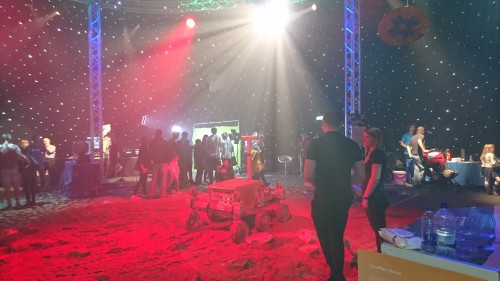
A prototype of the ExoMars rover trundles around inside the “space dome” at the Cheltenham Science Festival.
By Margaret Harris
How do you keep an astronaut alive, sane and (ideally) happy during a mission to Mars? The world’s space agencies would very much like to know the answer, but gathering data is tricky. The International Space Station (ISS) makes a good testbed for experiments on the physical effects of space travel, but psychologically speaking, ISS astronauts enjoy a huge advantage over their possible Mars-bound counterparts: if something goes badly wrong on the station, home is just a short Soyuz ride away. Martian astronauts, in contrast, will be on their own.
For this reason, space agencies have become interested in learning how people cope in extreme environments here on Earth, particularly in locations where rescue is not immediately possible. That’s why the European Space Agency (ESA) sent Beth Healey, a British medical doctor, to spend the winter of 2015 at Concordia Research Station, a remote base in the interior of Antarctica. During the continent’s nine-month-long winter, temperatures at Concordia can plunge as low as –80 °C, making it inaccessible even to aeroplanes, which cannot operate at temperatures below –50 °C. So once the last flight left in February 2015, Healey and the 12 other members of the overwintering team were stuck there until November.
View all posts by this author | View this author's profile
China’s chief Moon scientist Ziyuan Ouyang outlines lunar plans
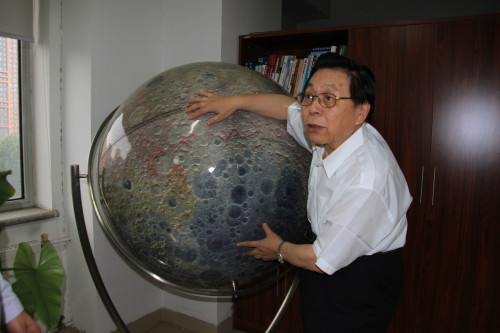
The Moon man: Ziyuan Ouyang in his office at the National Astronomical Observatories with a lunar globe covered with images taken by Chinese craft. (Courtesy: Mingfang Lu)
By Matin Durrani in Beijing, China
I caught up this morning on the second day of my visit to Beijing with Ziyuan Ouyang, chief scientist of China’s Moon programme at the National Astronomical Observatories, which lies not far from the city’s iconic “bird’s-nest” Olympic stadium.
I’d first met Ouyang on my last visit in 2011 when the country had so far launched two lunar missions – Chang’e 1 (which orbited the Moon for 18 months before crash-landing onto the lunar surface) and Chang’e 2 (another lunar orbiter that later moved off into interplanetary space).
China’s lunar efforts have continued and Ouyang explained to me what has happened since my last visit – and what the country plans to do next.
View all posts by this author | View this author's profile
LISA Pathfinder opens the door to gravitational-wave detection in space
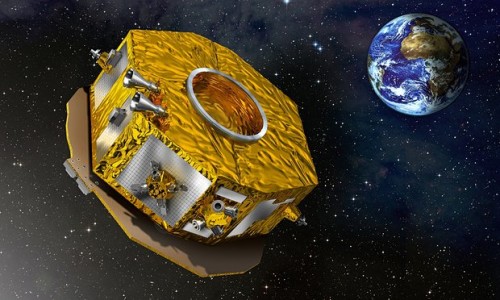
Flying high: LISA Pathfinder has overcome a major hurdle. (Courtesy: ESA)
By Hamish Johnston
2016 is shaping up to be a bumper year for physicists trying to detect gravitational waves. In February the LIGO collaboration announced the first ever direct detection of gravitational waves using two kilometre-sized detectors in the US.
Now, it looks like an even bigger detector will get permission to launch. Researchers working on the LISA Pathfinder space mission have just announced that they were able to isolate a 2 kg test mass at a special “Lagrangian point” between the Earth and the Sun. This is important because the planned LISA gravitational-wave observatory will use test masses located at three points in space (each separated by about one million kilometres) as the basis for a huge detector.
Rosetta and bedbugs, LIGO and dark matter, arXiving science and more…
By Tushna Commissariat
Space missions and insects are not the most usual of bedfellows. But in a wonderful example of how space technology can be translated into practical devices for use here on Earth, a UK company has repurposed and adapted an analyser used onboard the Rosetta mission – that in 2014 landed a probe on a comet for the first time – to sniff out bedbugs. The pest-control company, Insect Research Systems, has created a 3D-printed detector that picks up bodily gas emissions from bedbugs – such a device could be of particular use in the hotel industry, for example, where many rooms need to be quickly scanned. The device is based on the Ptolemy analyser on the Philae lander, which was designed to use mass spectroscopy to study the comet’s surface.
“Thanks to the latest 3D-printing capabilities, excellent design input and technical support available at the Campus Technology Hub, we have been able to optimize the design of our prototype and now have a product that we can demonstrate to future investors,” says Taff Morgan, Insect Research Systems chief technical officer, who was one of the main scientists on Ptolemy. In the TEDx video above, he talks about the many technological spin-offs that came from Ptolemy – skip ahead to 13:45 if you only want to hear about the bedbugs, though.